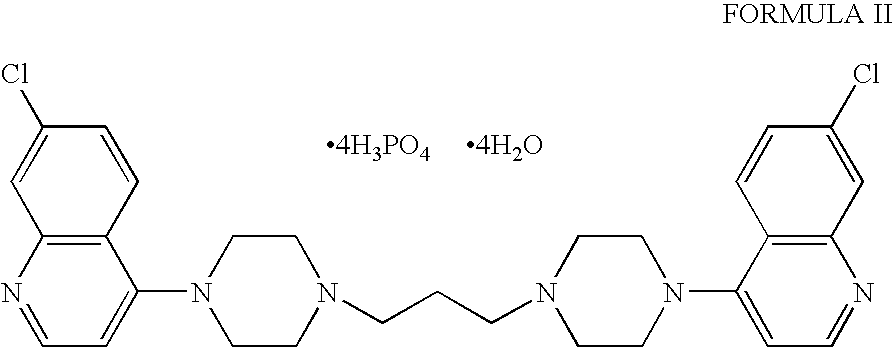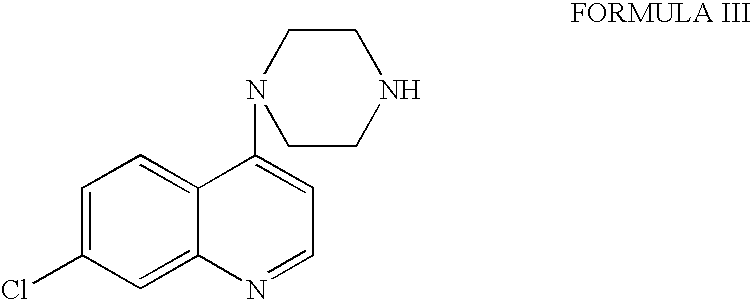Preparation of bisquinoline compounds
a technology of bisquinoline and compound, which is applied in the field of preparation of bisquinoline compounds, can solve the problems of high cost of solvent, low yield of reaction products and intermediates, and difficulty in scaling up protection and deprotection during the protection period, and achieves cost-effectiveness, high yield, and cost-effective
- Summary
- Abstract
- Description
- Claims
- Application Information
AI Technical Summary
Benefits of technology
Problems solved by technology
Method used
Image
Examples
example 1
Preparation of 7-chloro-4-(piperazin-1-yl) quinoline
[0031] A solution of 4,7-dichloroquinoline (59.4 g, 1 equivalent mole), piperazine (77.4 g, 3 equivalent mole)and potassium carbonate (41.4 g, 1 equivalent mole) in isopropyl alcohol (594 ml) was refluxed for 36 hours at 84-85° C. The mixture was cooled and then reheated to distill the solvent under reduced pressure. Water (1200 ml) was added into the reaction mixture, and the aqueous layer was extracted twice with dichloromethane (207 ml). The combined organic layer was concentrated and it was prolonged evacuated under low pressure. Hexane (240 ml) was added into the reaction mass and it was stirred for hour at room temperature, which afforded an off-white crystalline solid. The contents were filtered and washed with hexane (60 ml) and dried at 50-60° C. under vacuum for four hours to give 7-chloro-4-(piperazine-1-yl)quinoline (70.68 g), m.p. 113-115° C. [0032] Yield: 1.19 w / w. [0033] Purity (by HPLC): 96.64%.
example 2
Preparation of Piperaquine
[0034] A mixture of 7-chloro-4-(piperazine-1-yl) quinoline (40 g, 1 equivalent mole), 1,3-dibromopropane (16.15 g, 0.5 equivalent mole), sodium carbonate (20.4 g, 1.2 equivalent mole) in deionised water (400 ml) was heated under reflux for 15 hours at 100° C. The reaction mixture was cooled to room temperature and filtered. The product was washed with deionised water till neutral pH was achieved. The product was again heated in denatured spirit for two hours. Reaction mixture was cooled to room temperature and solid material was filtered and dried at 50-60° C. under vacuum for four to five hours to give 1,3-bis(1-7′-chloro-4-quinolyl-4-piperazinyl)propane (30 g). [0035] Yield: 0.8 w / w. [0036] Purity (by HPLC): 99.06%
example 3
Preparation of Piperaquine Phosphate
[0037] A suspension of 1,3-bis(1-7′-chloro-4-quinolyl-4-piperazinyl)propane (100 g, 1 equivalent mole) in water (1500 ml) was cooled up to 5-15° C. with stirring. A pre-prepared solution of ortho-phosphoric acid (85 ml, 4.0 equivalent) in water (500 ml) was drop wise added to the suspension during a period of 2 to 3 hours. The solution was allowed to stir for two hour at the same temperature. The solid product was filtered and washed with water (200 ml). The product was dried at 50-55° C. under high vacuum till water content reached 6-8% to obtain the title compound (170 g), m.p. 246-252° C. [0038] Yield: 1.70 w / w. [0039] Purity (by HPLC): 99.68%
PUM
| Property | Measurement | Unit |
|---|---|---|
| melting point | aaaaa | aaaaa |
| temperature | aaaaa | aaaaa |
| purity | aaaaa | aaaaa |
Abstract
Description
Claims
Application Information
 Login to View More
Login to View More - R&D
- Intellectual Property
- Life Sciences
- Materials
- Tech Scout
- Unparalleled Data Quality
- Higher Quality Content
- 60% Fewer Hallucinations
Browse by: Latest US Patents, China's latest patents, Technical Efficacy Thesaurus, Application Domain, Technology Topic, Popular Technical Reports.
© 2025 PatSnap. All rights reserved.Legal|Privacy policy|Modern Slavery Act Transparency Statement|Sitemap|About US| Contact US: help@patsnap.com



